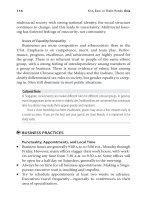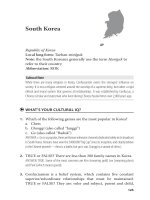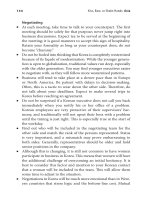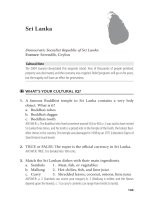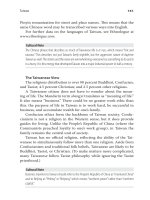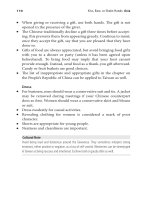How to Understand Business Finance Understand the Business Cycle Manage Your Assets Measure Business Performance Sunday Times Creating Success_1 potx
Bạn đang xem bản rút gọn của tài liệu. Xem và tải ngay bản đầy đủ của tài liệu tại đây (1.01 MB, 18 trang )
8 How to Understand Business Finance
Table 1.1 Common terms in English and US English
English US English Other
Accounts
Budget
Creditors
Debtors
Depreciation
Dividend
Equity
Factoring
Fixed costs
Funds fl ow
Gearing
Gross margin
Indirect costs
Internal rate of
return (IRR)
Loans
Net profi t
Profi t
Profi t and loss account
Reserves
Return on sales
Sales
Shares
Stock
Variable cost
Financial statements
Business plan
Payables
Receivables
Amortization
Drawings
Owners’ funds
Cash discounting
Expenses
Cash fl ow statement
Leverage
Gross profi t
Sales, general and
administration (SG&A)
DCF yield
Debt
Net income
Earnings
Income statement
Retained earnings
Return on revenue
Revenue
Stock
Inventory
Fluctuating cost
Books
Operational plan
Accounts payable
Accounts receivable
Burden, overheads
Contribution
Income, top line,
invoice value
Cost of goods sold
(COGS)
2
The business cycle
Setting up a company
Businesses diff er to such a huge degree that each one is truly
unique, and yet they all go through one simple process in much
the same way. We will call it the business cycle. They produce and
deliver a product or service, they invoice the customer, they pay
their bills, they get paid by their customers, and they do the books.
We are going to set up an imaginary company to demonstrate this
process. The business is represented visually in Figure 2.1.
Let’s take a look at our business. First, we’re going to rent
an industrial unit. This can accommodate up to four
production units and the rent will be the same whether we have
one unit or four.
We’d like to have some cash in this business. In reality this
would be held in a bank account (or in your back pocket if you
were a market trader!) but we’ll have a cash box on our premises
to place this cash in. Do we want to have a lot or only a little
money in this cash box? Already we see a potential argument
brewing between departments, so let’s come back to this
question in a later chapter.
9
10 How to Understand Business Finance
90 DAYS 60 DAYS 30 DAYS
Figure 2.1 An imaginary business start-up
Next we’ll have an area representing the money owed to us by
customers. As you can see, we may have given our customers 30,
60 or 90 days to pay us and there is a box for each in our premises.
When we deliver goods we invoice our customers and depending
on the payment terms the money they pay should reach us in 30,
60 or 90 days. We can count that money but we can’t have it yet!
Month by month this money will move along, ever closer, until
eventually it will come into the cash box – and only then can we
spend it!
Underneath cash we have a ‘repay’ box. When anything hits
this area we have to pay it from cash. If we don’t have any cash we
must fi nd some or we are bankrupt. Never mind how much profi t
you are making, no cash means a bankrupt business.
On one side of this repay box we have the credit we can get
from suppliers after we have been trading for some time and
have established a track record. On the other side we have bank
loans – again, once we have a track record and provided we
11 The Business Cycle
meet the rules laid down by the banks we may be able to borrow
from them.
Lastly, down the right-hand side we have various costs
associated with running the business – rent, wages,
administration overheads etc.
What would you need to start a new business? At the
very minimum you would need:
An idea – a product or service. What is it you will be •
able to charge customers for (ie make a sale and
issue an invoice)?
Money – this is intentionally vague but you’ll need •
some sort of funding.
A plan – are you going to set up in your back room, •
rent an offi ce, DIY or hire staff etc? The better your
plan, the more likely your business is to survive and
succeed.
Let’s say our idea is to go into business installing white burglar
alarms. We’re going to buy in the white burglar alarm system and
we will charge people to install it in their homes.
Next we’ll need some money. Let’s represent this in grey
casino chips – each chip being worth £1,000. We’ll say that as
owners of this company we’ll put in £30,000 to start up the
business. This is represented by 30 grey casino chips which we
will place in cash, as shown in Figure 2.2.
12 How to Understand Business Finance
Figure 2.2 Cash for the business
The Moving Balance Sheet
®
We’re now going to invest this £30,000 in the business. We will
want to keep track of where we spend this money; at least, our
accountant will. We’ll start a table recording what we have in the
business and where the money came from. Obviously these two
things should always balance (ie be the same), or else we could
just give up working and ‘cook the books’ whenever we want a bit
of cash to spend – while it lasts. This is shown in Table 2.1.
To install these white burglar alarms we are going to need
some equipment – a van, ladders, tools etc, and we’ll say this will
cost us £5,000. So we’ll buy this equipment and install it in our
industrial unit. To pay for this we take £5,000 from cash and place
it on the equipment. This is a visual representation of the value of
that asset, as shown in Figure 2.3.
13 The Business Cycle
Table 2.1 Moving Balance Sheet
®
– Step 1
What we have:
Start business
Cash 30
Total 30
Where it came from:
Owners’ funds 30
Total 30
The Moving Balance Sheet
®
is a registered trade mark of Profi tAbility Business Simulations
Let’s look now at what we have in the business. We have £25,000
cash and the equipment valued at £5,000 making a total of
£30,000. Generally accountants like to value things at what they
cost. That’s the prudent thing to do.
Prudence
You will know that the tax man is very fond of prudence, but
you may not realise that all the accountants ever trained
have had prudence drummed into them until it’s part of their
personalities. Roget’s Thesaurus likens prudence to
14 How to Understand Business Finance
carefulness, sagacity, foresight, economy, caution etc. What
it boils down to in practice is that accountants are trained to
be cautious, risk-averse, and dubious about change.
‘How do you know when you are talking to an extrovert
accountant? They look at your shoes when speaking to you.’
Of course, we all know the exception to this stereotype, but
whatever an accountant’s personality, prudence is not very
exciting. An exceptional young accountant recently told us
he was moving away from extreme prudence, but on a scale
from 1–100, where 1 is extreme prudence, he reckoned he
might now be on 5. Accountants are generally more inclined
to hold you back than push you forward.
Figure 2.3 Value of equipment
15 The Business Cycle
Back to our record – where did the money come from? Well, we
put the money in to start the business so we’ll call it owners’ funds
and, as we put in £30,000, we balance, as shown in Table 2.2.
We’re ready to move on to the next step – we need to recruit
someone to work for us installing these alarms. Luckily there just
happens to be a guy walking down the street who is fully trained
and ready to start work for us. So we take him on and we’re ready
to go into business.
People – our greatest asset?
Let’s look again now at what we have in the business. From
the accountant’s standpoint nothing has changed – and
that’s the value that accountants put on people: nothing!
When the boss says that people are our greatest asset, you
know that he or she is not an accountant.
There are a very few exceptions to this rule of not ‘valuing’
people – for instance, football clubs often pay huge sums of
money for a player and so they put this ‘asset’ on the books
and then of course expect it to make a return – they sweat the
asset! But it’s a risky business. That player has only got to break
his leg and be unable to play again and that valuable asset is
no longer worth a penny, whatever you say in the books.
Raw materials
To be able to install these alarms we’re going to have to buy in the
alarm components – the electronics, wiring, alarm bells and so
forth. These raw materials are represented by white chips. If we
look at our equipment we can see that there are six spaces for
units of raw materials. That’s because our operator, Fred, can only
install six alarm systems in a month. There’s no overtime and no
night shift – he can only do six jobs a month.
16 How to Understand Business Finance
Table 2.2 Moving Balance Sheet
®
– Step 2
What we have:
Start business
Buy equipment
Cash 30 25
Equipment 5
Total 30 30
Where it came from:
Owners’ funds 30 30
Total 30 30
The Moving Balance Sheet
®
is a registered trade mark of Profi tAbility Business Simulations
So here’s a business problem for you: what are our options if we
win a contract to install seven alarm systems this month? Well, we
could deliver some this month and some next month. This is
known as staged deliveries and can lead to all sorts of problems –
batch to batch variation and disputes over how much has been
delivered. We could subcontract someone else to install an alarm
for us. Obviously we would need to pay that subcontractor and then
invoice the customer ourselves for the work that has been done.
We could buy some more equipment – another van, ladders
etc – and employ another person to install the alarms for us. Or we
could buy a company that is already in this business: make an
acquisition.
17 The Business Cycle
But let’s come back to our little example and our record. We’ve
agreed that we need to buy some raw materials. Each white alarm
system costs £2,000.
As we have capacity to install six units a month, let’s buy all
six. We go to a supplier and the rep says, ‘Never seen you before,
so you’ll have to pay cash.’ So let’s take delivery of the six units
and we’ll pay our supplier the £12,000 they cost from cash, as
shown in Figure 2.4.
We now have £13,000 cash in the business. The equipment is
worth £5,000 and we have some stock: £12,000 worth of raw
materials – what we paid for them. This adds up to £30,000.
Where’s it come from? Well, it’s the same £30,000 that we put in
to start the company in the fi rst place, as shown in Table 2.3.
Figure 2.4 Buying raw materials
18 How to Understand Business Finance
Table 2.3 Moving Balance Sheet
®
– Step 3
What we have:
Start business
Buy equipment
Buy equipment
Cash 30 25 13
Equipment 5 5
Stock 12
Total 30 30 30
Where it came from:
Owners’ funds 30 30 30
Total 30 30 30
The Moving Balance Sheet
®
is a registered trade mark of Profi tAbility Business Simulations
Creating value
Let’s review what this might look like in the real world. We’ve set
up a company, found premises, developed a product and service,
installed equipment, recruited staff , bought in raw materials,
and now we are ready to sell those products and services. Have
we added any value yet? Well, everything we have in the
company is still only worth £30,000, which is the same as our
original stake.
19 The Business Cycle
To ‘create value’ we need to sell something for more than it
costs to supply. Let’s say we fi nd a customer who wants us to
install fi ve alarm systems and they are prepared to pay £20,000.
We deliver the fi ve white alarm units and the customer pays us
our £20,000. The good news is we’ve made a sale – the bad news
is that our customer is not going to pay us for 30 days. This
£20,000 therefore goes on a box marked ‘customer 30 days’ to
the left of the cash box as shown in Figure 2.5 and we will now
have to wait until next month to receive these funds.
When is a sale a sale?
There are many potential answers to this, and here are some
of them:
Salespeople say that it’s when you get the order.
Accountants disagree. They don’t go in for promises as a
rule, and so will not put anything in the books based on
orders. Worse, from the salesperson’s point of view, the
accountant will record all the costs of winning the order, with
no recognition of the salespeople’s hard work!
The legal department might say that it’s when the signature
is on the contract.
Accountants disagree again. Legally binding is not
suffi cient for them.
The common-sense answer is often: when we get paid. It
is a long-standing cliché that the sale is not complete until
the money is in the bank.
Accountants disagree yet again. They call a sale a sale at
the point that an invoice is raised. When is a sale made in an
accountant’s eyes? It’s when we can put it in the books and
that is when we’ve issued an invoice!
20 How to Understand Business Finance
Figure 2.5 Delivery of goods and payment arrangements
If you’re in a consultancy business you don’t create value for
your own business when you win a contract, not in the
accountant’s eyes. You don’t even create value for your own
business when you deliver the service. You create value when
you invoice the customer and that could be some time later when
you’ve prepared all your time sheets and you’ve calculated how
much to invoice the client. At least, that’s how the accountant
sees it.
Cash and profi t
Looking at what we have in the business now – we still have
£13,000 cash, the equipment is still valued at £5,000, and we have
something else we will call ‘owed by customers’: an outstanding
invoice for £20,000. This all adds up to £40,000.
21 The Business Cycle
Where’s it come from? Well, we know that £30,000 came from
the owners. But can you see that the accountants can’t now
balance the books. So they invented something called profi t,
shown in Table 2.4. How much is it? Well, it must be £10,000 to
balance the books!
This is an unusual way to demonstrate profi t but we’ve done it
this way to show that profi t is simply a sum that the accountants
do. You can’t see it or touch it. In fact, there isn’t a pile of £10,000
in sight. But what about cash? That you can see, touch and feel.
You’ve only got to check in your cash box (the bank) to fi nd out if
you have any – we have £13,000, but profi t was £10,000.
Table 2.4 Moving Balance Sheet
®
– Step 4
What we have:
Start business
Buy equipment
Buy stock
Sell 5 units for 20
Cash 30 25 13 13
Equipment 5 5 5
Stock 12 2
Owed by customers 20
Total 30 30 30 40
Where it came from:
Owners’ funds 30 30 30 30
Profi t10
Total 30 30 30 40
The Moving Balance Sheet
®
is a registered trade mark of Profi tAbility Business Simulations
22 How to Understand Business Finance
Cash and profi t – not twin sisters
So cash and profi t are not the same. This is perhaps one of
the most crucial concepts of fi nance, and one of the most
misunderstood. Profi t is a sum, nothing more. Only cash
is real.
Cash and profi t – food and oxygen
Profi t is like food. If you had nothing to eat for the rest of
today, you would be hungry and might be cross, but you
would be alive. Even after several days, perhaps weeks, you
can keep going as long as you have air and water; and so it is
for companies when they don’t make a profi t. But cash is like
oxygen. No oxygen for several minutes, and you would be
dead. No cash in a business, and within days it is also dead.
Services are cut off , unpaid staff stop working, suppliers
won’t supply the materials you need, and the whole thing
grinds to a halt. So, to keep the business healthy, you have
to manage both: profi t for the long term, and cash for the
short term.
Lastly, what’s going to happen in 30 days? Remember that
customer who still owes us some money? Well, in the real world,
after 30 days we may have to start chasing that customer to pay us
but in our example we are paid on time. So cash goes up to
£33,000, as shown in Figure 2.6, money owed by customers goes
to zero and this still adds up to £40,000.
Of this, £30,000 came from owners’ funds and £10,000 from
profi t, shown in Table 2.5.
We have seen that cash and profi t are not the same, but do they
change at the same time, and in the same way? Well, let’s look at the
23 The Business Cycle
Figure 2.6 Receiving customers’ payment
various activities that take place in any company. We buy equipment,
raw materials, make a sale, collect money from customers etc on a
regular basis. Between buying the raw materials and selling, did our
cash change? No, cash was £13,000 before we sold the stock and
£13,000 afterwards. What about profi t? That went from zero to
£10,000. So cash and profi t are not the same although they are linked.
Now let’s look at the eff ect of a customer paying an
outstanding invoice. Cash leapt from £13,000 to £33,000 but profi t
remained at £10,000.
So, we’ve seen two examples of levers we can pull to aff ect our
fi nancial performance: making a sale (invoicing a customer) can
generate a profi t, while collecting money from a customer gives us
cash but no additional profi t.
What we have constructed here is a balance sheet – a statement
of what we have in the company and how it is funded. Accountants
call things we have ‘assets’ and things we owe ‘liabilities’.
24 How to Understand Business Finance
Table 2.5 Moving Balance Sheet
®
– Step 5
What we have (Assets):
Start business
Buy equipment
Buy stock
Sell 5 units for 20
Customer pays
Cash 30 25 13 13 33
Equipment 5 5 5 5
Stock 12 2 2
Owed by customers 20 0
Total 30 30 30 40 40
Where it came from
(Liabilities):
Owners’ funds 30 30 30 30 30
Profi t1010
Total 30 30 30 40 40
The Moving Balance Sheet
®
is a registered trade mark of Profi tAbility Business Simulations
Owners’ funds – a liability?
So why are owners’ funds a liability? Well, the owners might
just want them back. Technically, the business owns nothing;
it is run on behalf of the shareholders. In theory these
shareholders could demand their funds back from the
company. In practice, however, if a company is wound up
25 The Business Cycle
they are the last to get paid. The fi rst to be paid are the
receivers or administrators called in if a business has ceased
trading. Next is the taxman, then the banks, followed by
suppliers, employees and, at the very end, if there is
anything left, the owners.
We’ll fi nish this section by considering the business cycle over
time. Suppose we looked at our business over a month. Some of
the activities we have considered happen at the beginning of the
month – for instance, we might buy new equipment and recruit
staff at the start of the month as it could take all month to
commission the plant and train the staff . Depending on our
payment terms our customers should pay us at certain times in
the month.
And, of course, we expect to receive our salary on a set day of
the month. How would you feel if your employer said, ‘Bit short of
cash, so I’m not paying your salary when it’s due, you’ll have to
wait another week’?
So, in every business there is a specifi c business cycle with
cash coming in and going out. Some of that is controllable by
managers and other parts are non-controllable (eg tax and wages)
– they have to be paid on a specifi c date.
Setting up and running the
business – the opening month
Let’s start with a clean sheet of paper and start this imaginary
company again. Our opening month can be January. Once more
we’ll need some money to start up the business so we’ll put £30,000
in cash into the business from the owners (see earlier, Figure 2.2).
Next we’ll need to buy some equipment. As before we’ll buy
equipment to install white burglar alarms. We take £5,000 from



